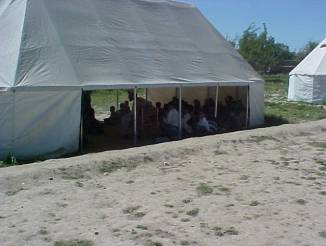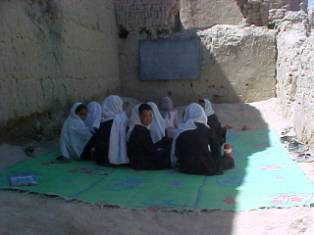| BRD
BRD PROGRAMS
WHO IS WHO IN BRD
NADDLE CRAFT PROGRAM
PLAN FOR ESTABLISHMENT OF WOMEN DEVELOPMENT CENTER
LATEST NEWS OF BRD
HELP AFGHAN WOMEN BUYING HANDYCRAFT PRODUCTS
DECLARATION OF AFGHAN WOMEN RIGHTS
MOST FAMOUS AFGHAN WOMEN
BDR PICTURES 1
BRD PICTURES 2
GUEST BOOK
LINKS TO THE HELP
TELL US ABOUT YOU
|
|
DECLARATION AFGHAN WOMEN RIGHTS
Declaration of the Essential Rights of Afghan Women
The Declaration
Dushanbe, Tajikistan, June 28, 2000
SECTION I
Considering that the Universal Declaration of Human Rights, as well as the international statements addressing the rights of women listed in Section II of this document, are systematically trampled in Afghanistan today;
Considering that all the rules imposed by the Taliban concerning women are in total opposition to the international conventions cited in Section II of this document;
Considering that torture and inhumane and degrading treatment imposed by the Taliban on women, as active members of society, have put Afghan society in danger;
Considering that the daily violence directed against the women of Afghanistan causes, for each one of them, a state of profound distress;
Considering that, under conditions devoid of their rights, women find themselves and their children in a situation of permanent danger;
Considering that discrimination on the basis of gender, race, religion, ethnicity and language is the source of insults, beatings, stoning and other forms of violence;
Considering that poverty and the lack of freedom of movement pushes women into prostitution, involuntary exile, forced marriages, and the selling and trafficking of their daughters;
Considering the severe and tragic conditions of more than twenty years of war in Afghanistan.
SECTION II
The Declaration which follows is derived from the following documents:
United Nations Charter
Universal Declaration of Human Rights
International Covenant on Economic, Social and Cultural Rights
International Covenant on Civil and Political Rights
Convention on the Rights of the Child
Convention on the Elimination of All Forms of Discrimination Against Women
Declaration on the Elimination of Violence Against Women
The Human Rights of Women
The Beijing Declaration
The Afghan Constitution of 1964
The Afghan Constitution of 1977
SECTION III
The fundamental right of Afghan women, as for all human beings, is life with dignity, which includes the following rights:
1. The right to equality between men and women and the right to the elimination of all forms of discrimination and segregation, based on gender, race or religion.
2. The right to personal safety and to freedom from torture or inhumane or degrading treatment.
3. The right to physical and mental health for women and their children.
4. The right to equal protection under the law.
5. The right to institutional education in all the intellectual and physical disciplines.
6. The right to just and favorable conditions of work.
7. The right to move about freely and independently.
8. The right to freedom of thought, speech, assembly and political participation.
9. The right to wear or not to wear the chadari (burqa) or the scarf.
10. The right to participate in cultural activities including theatre, music and sports.
SECTION IV
This Declaration developed by Afghan women is a statement, affirmation and emphasis of those essential rights that we Afghan women own for ourselves and for all other Afghan women. It is a document that the State of Afghanistan must respect and implement. This document, at this moment in time, is a draft that, in the course of time, will be amended and completed by Afghan women.
|
 Schools in Kabul
Schools in Kabul
|
|
As a result of UN sponsored negotiations in Bonn, Germany, the Afghan Interim Administration took office on December 22, 2001. The Bonn agreement also established the Ministry of Women's Affairs and the Independent Human Rights Commission to improve and safeguard women's rights and human rights. Women have gone back to work. Schools have reopened for girls and women. Women can now go outside of their homes. But these gains are fragile. The restoration of peace, democracy, and women's rights are not possible without resources and adequate security.
|
|
Afghanistan
23 years of continuing war have brought many problems to the people of Afghanistan and increased their vulnerability, especially in Rural Areas of the country.
The Education sector has especially been seriously damaged during the six years of Taliban tyranny, during which they sought to remove the root of education from the country, especially education for girls.
After the removal of the Taliban, the new government has given wide opportunities in education for Afghanis male and female. As work has started on this, the government has recognized this problem needs more resources. Unicef is doing more than other organizations to provide assistance to improve the education sector in the country, but still there is need for more commitment, contribution, and resources to respond to the need of the community in Afghanistan.
Currently there are these existing problems in the education sector:
There are no facilities for girls and boys education in the rural area (books, school buildings, stability and salary support for the teachers) and some of the schools are functioning in open space without the necessary conditions. Some facilities are simply tents.
The community does have in interest to educate their children (both girls and boys) but there are no teachers to provide this service.
Only 70% of the existing schools have potable water and sanitation facilities.
There is an urgent need for conducting Literacy classes for adult women who are reminded of education in the past, but at the moment this program is limited only to urban areas. In the rural areas, the people are not ready to permit the women to attend Literacy classes. This issue simply needs time and community awareness.
The male is the only supporter of family in Afghanistan, and during the years of wars the majority of women have lost their male partner. Now these widows have no income, and support their children and the family with no existing job opportunities.
The literacy rate among the women is very low in Afghanistan and the majority of women are not aware of their basic rights. Also, there are continued violations against women and because of the lack of awareness, their protection remains scarce.
Health facilities are very limited for women and children in the rural area. The maternal death rate is very high due to lack of a healthy delivery system in these rural areas.
There are limited resources and opportunities for educated women, such computer access, English language courses, and internet access for women to link with the world and share their problems with other women communities in the world.
Afghan Women and Education
|
 Afghan girls attending lectures
The schools are no regular buildings, just an improvised space.
Afghan girls attending lectures
The schools are no regular buildings, just an improvised space. |
|
|

